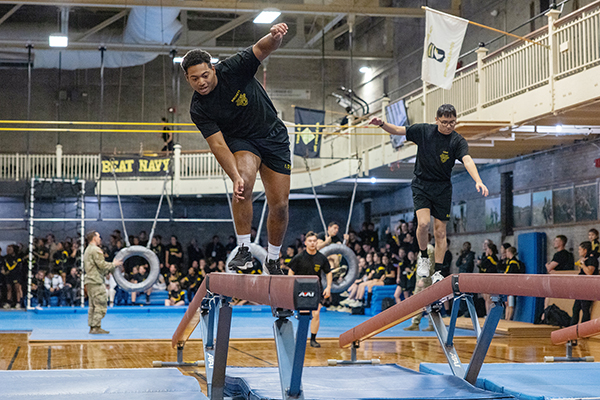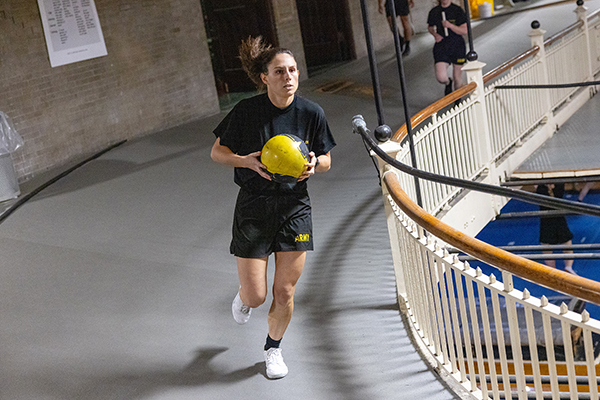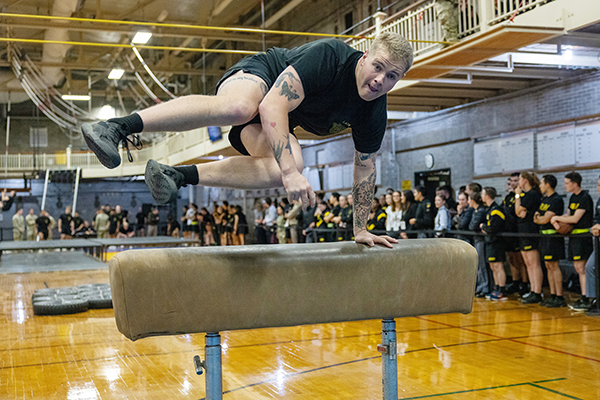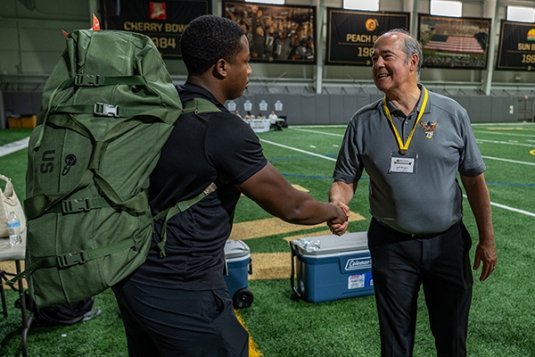It’s a test of physical endurance, brute strength, and the mental will to achieve past one’s bodily limits as U.S. Military Academy second- and first-class cadets push themselves during the Indoor Obstacle Course Test (IOCT) on November 20 at Hayes Gymnasium in the Arvin Cadet Physical Development Center.
The IOCT, which began in 1944 during the later stages of World War II, has undergone various changes to the current testing that has been used since 1986. It is also a graduation requirement for all cadets.
“They are mandated to take and pass the test their second- and first-class years at the academy and must pass the course at least once in order to graduate,” said CPT Dominic Bisesi, a rotating military officer instructor in the Department of Physical Education and the lead testing officer, along with CPT Patrick Branham ’15, for the IOCT.
Bisesi plans and executes all the IOCTs for the Corps of Cadets. On the event day, he and Branham oversee the setup, grade validation, briefing, and overall execution of the test.
Cadets are introduced to the 11-event IOCT during PE117 Military Movement during their sophomore year (third-class year) and take it as a graded event in the class.

“The test does an excellent job of testing cadets’ anaerobic and aerobic fitness as well as their muscular strength,” said Bisesi, who teaches a variety of core activity and lifetime physical activity classes in DPE. “Their ability to maneuver over and through obstructions are trained with various obstacles such as the tire run, hanging tires, balance beam, etc. Many of these obstacles closely mimic terrain that can be found in urban and wooden environments.”
Bisesi said cadets seem to have the most struggles with two events: the Shelf, which is located after the two-handed vault over a gymnastics beam and requires them to propel themselves onto the eight-foot platform, and the 16-foot Rope Climb. The testing concludes with a 350-meter sprint that includes carrying a six-pound medicine ball the first 120 meters, a baton the next 120 meters, and then finishing the remaining 110 meters empty-handed.
“I think the corps showing up to cheer on their friends and peers in Hayes Gym creates an extremely motivating environment,” Bisesi exclaimed. “It pushes many cadets past their usual level of performance.”
Within the testing, males can receive an A+ grade by completing the IOCT in 2 minutes, 26 seconds or less, but need to finish in under 3:31 to get a passing grade. Females receive an A+ grade by completing the course in 3:14 or less but need to finish in less than 5:30 to pass. If cadets obtain an A- grade or above, they receive an IOCT tab and if they do it their second-class year, they are exempt from taking the ICOT their firstie year.
Two cadets who were driven to achieve a high grade were Class of 2026 CDTs Luke Jegeris and Nicholas Marchese. Jegeris, who participates with the Alpine Ski Club team at West Point, felt rather good about his performance at the IOCT.

“While I know I can do better, overall, I’m pretty happy with my performance as it was my first (IOCT) in a while,” Jegeris explained.
Jegeris said he got a time of 2:42, which equates to a B grade, and felt that “my ability on the obstacles was pretty fluid.” He said the hardest part for him were the sprints at the end of the test, but preparing three times a week for the last three weeks prepared him well.
As for Marchese, he was happy with his performance and thought, “once I got up the rope, I was like ‘oh, now I just have to go hard’ because I felt the (track) was fast, and I flew.” Marchese trained during the week leading up to the ICOT and said he finished one second better than his grade during Military Movement class a year ago.
For both cadets, the environment inspired them to drive through the agony that the 114-year-old Hayes setting can cause cadets as many find themselves hacking, coughing or even vomiting at the end of the course. But beyond the physical discomfort, Marchese said it is a stark difference than performing it in class.
“I like this environment, and it wasn’t as depressing as when you take it in class,” Marchese explained. “I enjoyed everyone watching and motivating me.”
Jegeris reiterated Marchese’s sentiment with the difference of the class atmosphere compared to the raucous cheering cadet test setting.
“It’s a lot better than taking it in class,” Jegeris said. “It was the first time I’ve done it in front of a bunch of cadets in this environment. I would say the crowd definitely helped a lot – it was a lot of fun.”
Excerpt and image taken from https://www.westpoint.edu.




